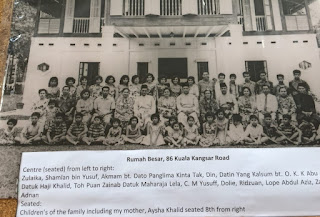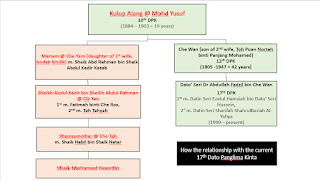Assalam Salam Sejahtera. Selamat datang ke blog saya. Untuk konten blog saya kali ini saya ingin berkongsi susur galur berkenaan keturunan saya dan bagaimana sejarah hubungan keluarga saya dengan Dato Panglima Kinta ke sepuluh Kulup Alang Mohamed Yusuf di Negeri Perak Darul Ridzuan. Ikuti kupasan lanjut daripada Bapa Saudara saya Shaikh Mohammed Noordin.
History of Dato Panglima Kinta
by Shaikh Mohamed Noordin
My intention of documenting our family tree is to help you understand how we are connected to our common ancestor, the tenth Dato Panglima Kinta, Kulup Alang @ Mohamed Yusuf. This family tree, therefore, focuses on the descendants of DPK Kulup Alang Yusuf and his first wife Andak Sindik. It helps track the connections with other relatives among Andak Sindik’s grandchildren and their descendants. Andak Sindik was daughter of Uda Kecil, an aborigine chief of the Temiar tribe, who was also an elephant herder of DPK Kulup Alang Yusuf.
At the same time, it will also help you understand how Kulup Alang Yusuf was connected to his ancestors. Probably not many of us know why Bangsa DiRaja was used as the salutation for all Dato Panglima Kinta, including that of the tenth Dato Panglima Kinta, the Orang Kaya-Kaya Panglima Kinta Seri Amar Bangsa DiRaja.
For your information, our genealogy can be traced to the second Sultan of Perak, Sultan Mansur Shah I, who reigned from 1549 to 1577. Sultan Mansur Shah I was indeed the ancestor of DPK Kulup Alang Yusuf. One of the Sultan’s wives was a daughter of an aborigine chief of the Semang tribe. They had a son named To’ Chengkat Piatu @ Kulop Kinta, who was born in 1578.
To’ Changkat Piatu’s older brothers were Sultan Ahmad Tajuddin Shah (the third Sultan of Perak, 1577–1584) and Sultan Tajul Ariffin Shah (the fourth Sultan of Perak, 1584–1594). To’ Changkat Piatu married Putri Mazwin, the daughter of the aborigine chief of the Temiar tribe. They had a son named To’ Chendang, who was later conferred the title Seri Maharaja Kinta by Sultan Muzaffar Shah II (the tenth, Sultan of Perak, 1636–1653).
 |
| House of the tenth DPK, Kulup Alang Mohd Yusuf |
To’ Chendang was reputed to be the only person to have ever held the title of “Maharaja” before it was changed to “Panglima” (Dato Panglima Kinta, or DPK). To’ Chendang’s wife was Putri Fatimah and their son, To’ Tambak, later
held the honour of being the First DPK (1670-1710).
To’ Tambak himself had two wives. The first was the mother of To’ Changkat Saga, while the second was Toh Puan Intan binti Tok Nyior Manis @ Toh Senongsa Seri Nara Wangsa IV, the mother of To’ Changkat Rembiah. Toh Intan’s father, Tok Nyior Manis, was a great-great-grandson of Tun Kelalang bin Tun Saban Balik who, in 1528, was the first Malay ruler of the Kinta district.
The marriage between To’ Tambak and Toh Puan Intan had resulted in the family holding two main positions in the Kinta District: Panglima Kinta Seri Amar Bangsa Di Raja (the eighth Perak Nobleman), who ruled the Kinta District, and Toh Senongsa Seri Nara Wangsa (the sixteenth Perak Nobleman) whose position normally belonged to the Kepayang descendants. Subsequently it became customary for the DPK of the Paloh House to marry aborigine ladies in order to maintain their status as Kulup or Chief or King of the aboriginal people.
Both To’ Changkat Saga and To’ Changkat Rembiah started the two houses of Dato Panglima Kinta, namely the House of Paloh and the House of Kepayang. Each house alternately provided a candidate for the Dato Parglima Kinta (DPK) title on a rotation system.
 |
| Andak Sindik's eldest grandson C M Yusuf at Conference of Commonwealth's speakers in London. |
The Second DPK (1710-1740) was To’ Changkat Saga, the First DPK candidate for the Paloh House. This was followed by To’ Changkat Rembiah of the Kepayang House as the third DPK (1740-1755). The fourth DPK (1755-1765) was To’ Paloh, followed by the fifth DPK (1765–1795) who was also famously known for his “untraceable disappearance”. His name was Ngah Abdul Gaffar @ Ngah Ghafor @ Tok Hilang Dijalan.
The sixth DPK (1795–1820) was Ngah Sudin of the Paloh House. Unfortunately, the rotation between these two houses was disrupted after the Seventh DPK (1820–1876), Ngah Jabor or Tok Gemok, was deposed by the British for his involvement in the murder of J.W.W. Birch in 1875.
Hence Ngah Jabor’s position was taken over by his second cousin, Ngah Abdul Lasam @ Ngah Sam of Paloh House as the eighth DPK (1795–1820). The rotation was restored by Ngah Sudin’s two grandsons, Ngah Abdul Lasam @ Ngah Sam the eighth DPK (1876–1877), and Uda Zainal Abidin @ Tok Cabut, the ninth DPK (1877–1884), and their descendants.
Although Ngah Abdul Lasam was briefly in the office as DPK which was about a year, his contribution to the state of Perak as Toh Muda to Ngah Jabor was quite remarkable. His knowledge in aboriginal mystics of taming the wild elephants helping him to save Perak from the war with Siam.
In 1821, Siam under King Rama II – Phra Phutthaloela (1809 – 1824) invaded Kedah and Perak in retaliation to friendly relations between Perak and Kedah. Perak was forced to send tributes in the form of gold flowers as a sign of subservience to under Siam just like Kedah.
However, Sultan Abdul Malik Mansur ibni Almarhum Sultan Ahmaddin Shah, the nineteenth Sultan of Perak (1806–1825) had refused to bow down to Siam’s demands. Nevertheless, after a few years, Sultan Abdul Malik Mansur Shah presented to King Rama II, the King of Siam, a peculiar trait of elephant named Chapang Pileh which means “selection”.
The
elephant was found by Toh Muda Panglima Kinta Ngah Abdul Sam then, before he
become eighth DPK while in the forest in Kinta. King Rama II was very fond of
it and he later liberated Perak from Siamese rule and agreed to exemp Perak from paying tribute of gold flowers to Siam.
 |
| Andak Sindik with her first daughter Che Ah. The boy in front was Chik Shamlan. |
 |
| Dato Bendahara C M Yusuf. |
 |
| Andak Sindik's sons in law with her eldest grandson, C. M. Yusuf. |
Ngah Lasam’s elder son, Lope Abdul Rani @ Durani, was appointed as Toh Muda DPK and was supposed to have succeeded DPK Uda Zainal. However, he died in 1881 before he could assume the title. As a result, the succession was passed to his younger brother (by a different mother) Kulup Alang Yusuf, our common ancestor who subsequently became the tenth DPK (1884–1903). After Kulup Alang Yusuf, an heir of Uda Zainal’s – an only son, was conferred the eleventh DPK. He was Ngah Abdul Wahab, who held the title for just two years, from 1903 to 1905.
Ngah Wahab however left no male heir. Kulup Alang Yusuf, on the other hand, had nine wives and abundant potential heirs as candidates for the DPK. Alas, his first wife Andak Sindik also produced no male heirs. This was unfortunate given that all her children were Kulup’s eldest by virtue of her being the first wife. Of Andak Sindik’s three daughters, only Che Mariam had sixteen children. The other two daughters Che Zaliha (Che Ah) and Che Yang Kalsom (Che Yai) were childless. Che Ah and Yang Kalsom had adopted some of Che Mariam’s children.
 |
| Sons in law of Andak Sindik |
 |
| Che Mariam and Yang Kalsom. The child was Wan Fatimah, the youngest daughter of Che Mariam bt Kulup Yusuf. |
Naturally after Ngah Wahab the DPK was monopolized by Kulup Alang Yusuf’s family, from whom three of his sons – Cik Wan, Cik Tak and Mohamed Eusuff – became the twelfth (1905-1947), thirteenth (1947–1951) and fourteenth DPK (1951–1957) respectively. One of Kulup’s grandsons, Tawil Azhar bin Oneh Ahmad, also became the fifteenth DPK (1957-1980) before it passed to his elder brother’s great-grandson, Dato’ Seri Azizul Hassan, as the sixteenth DPK (1980–1999). The seventeenth and present DPK (1999 – current) is Dato’ Seri Dr Abdullah Fadzil bin Che Wan, who is also Kulup Alang Yusuf’s grandson.
PS: Some of the names used in the family tree are only commonly known names to the person. Therefore, the information can always be updated if any corrections need to be made at any time.
 |
| Big family gathering at Rumah Besar of Jalan Kuala Kangsar |
Special Thanks
I am especially indebted to Tuan Haji Fazil Shuhaimi bin Hi Talib, the President of Persatuan Keluarga Kulup Kinta for providing me the masterpieces of the family trees of Dato Panglima Kinta and other relevant information materials as my main source of reference.
Family tree Guidelines: -
1. DPK = stands for Dato Panglima Kinta
2. Name in green box = stands for male
3. Name in pink box = stands for female
4. Name in Bold = stands for direct decedent
5. Name in Italic = stands for spouses





















No comments:
Post a Comment